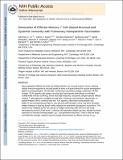| dc.contributor.author | Li, Adrienne Victoria | |
| dc.contributor.author | Moon, James J. | |
| dc.contributor.author | Abraham, Wuhbet | |
| dc.contributor.author | Suh, Heikyung | |
| dc.contributor.author | Elkhader, Jamal | |
| dc.contributor.author | Seidman, Michael A. | |
| dc.contributor.author | Yen, Minmin | |
| dc.contributor.author | Im, Eung-Jun | |
| dc.contributor.author | Foley, Maria Hottelet | |
| dc.contributor.author | Barouch, Dan H. | |
| dc.contributor.author | Irvine, Darrell J. | |
| dc.contributor.author | Yen, Minmin | |
| dc.date.accessioned | 2014-12-01T19:13:10Z | |
| dc.date.available | 2014-12-01T19:13:10Z | |
| dc.date.issued | 2013-09 | |
| dc.identifier.issn | 1946-6234 | |
| dc.identifier.issn | 1946-6242 | |
| dc.identifier.uri | http://hdl.handle.net/1721.1/91969 | |
| dc.description.abstract | Many pathogens infiltrate the body and initiate infection via mucosal surfaces. Hence, eliciting cellular immune responses at mucosal portals of entry is of great interest for vaccine development against mucosal pathogens. We describe a pulmonary vaccination strategy combining Toll-like receptor (TLR) agonists with antigen-carrying lipid nanocapsules [interbilayer-crosslinked multilamellar vesicles (ICMVs)], which elicit high-frequency, long-lived, antigen-specific effector memory T cell responses at multiple mucosal sites. Pulmonary immunization using protein- or peptide-loaded ICMVs combined with two TLR agonists, polyinosinic-polycytidylic acid (polyI:C) and monophosphoryl lipid A, was safe and well tolerated in mice, and led to increased antigen transport to draining lymph nodes compared to equivalent subcutaneous vaccination. This response was mediated by the vast number of antigen-presenting cells (APCs) in the lungs. Nanocapsules primed 13-fold more T cells than did equivalent soluble vaccines, elicited increased expression of mucosal homing integrin α4β7+, and generated long-lived T cells in both the lungs and distal (for example, vaginal) mucosa strongly biased toward an effector memory (TEM) phenotype. These TEM responses were highly protective in both therapeutic tumor and prophylactic viral vaccine settings. Together, these data suggest that targeting cross-presentation–promoting particulate vaccines to the APC-rich pulmonary mucosa can promote robust T cell responses for protection of mucosal surfaces. | en_US |
| dc.description.sponsorship | Howard Hughes Medical Institute (Investigator) | en_US |
| dc.description.sponsorship | National Institutes of Health (U.S.) (AI095109) | en_US |
| dc.description.sponsorship | United States. Dept. of Defense (contract W911NF-07-D-0004) | en_US |
| dc.description.sponsorship | Bill & Melinda Gates Foundation | en_US |
| dc.description.sponsorship | Ragon Institute of MGH, MIT, and Harvard | en_US |
| dc.description.sponsorship | National Cancer Institute (U.S.) | en_US |
| dc.description.sponsorship | David H. Koch Institute for Integrative Cancer Research at MIT (Koch Institute Support (core) Grant P30-CA14051) | en_US |
| dc.language.iso | en_US | |
| dc.publisher | American Association for the Advancement of Science (AAAS) | en_US |
| dc.relation.isversionof | http://dx.doi.org/10.1126/scitranslmed.3006516 | en_US |
| dc.rights | Creative Commons Attribution-Noncommercial-Share Alike | en_US |
| dc.rights.uri | http://creativecommons.org/licenses/by-nc-sa/4.0/ | en_US |
| dc.source | PMC | en_US |
| dc.title | Generation of Effector Memory T Cell-Based Mucosal and Systemic Immunity with Pulmonary Nanoparticle Vaccination | en_US |
| dc.type | Article | en_US |
| dc.identifier.citation | Li, A. V., J. J. Moon, W. Abraham, H. Suh, J. Elkhader, M. A. Seidman, M. Yen, et al. “Generation of Effector Memory T Cell-Based Mucosal and Systemic Immunity with Pulmonary Nanoparticle Vaccination.” Science Translational Medicine 5, no. 204 (September 25, 2013): 204ra130–204ra130. | en_US |
| dc.contributor.department | Massachusetts Institute of Technology. Department of Biological Engineering | en_US |
| dc.contributor.department | Massachusetts Institute of Technology. Department of Materials Science and Engineering | en_US |
| dc.contributor.department | Ragon Institute of MGH, MIT and Harvard | en_US |
| dc.contributor.department | Koch Institute for Integrative Cancer Research at MIT | en_US |
| dc.contributor.mitauthor | Li, Adrienne Victoria | en_US |
| dc.contributor.mitauthor | Moon, James J. | en_US |
| dc.contributor.mitauthor | Abraham, Wuhbet | en_US |
| dc.contributor.mitauthor | Suh, Heikyung | en_US |
| dc.contributor.mitauthor | Elkhader, Jamal | en_US |
| dc.contributor.mitauthor | Yen, Minmin | en_US |
| dc.contributor.mitauthor | Im, Eung-Jun | en_US |
| dc.contributor.mitauthor | Foley, Maria Hottelet | en_US |
| dc.contributor.mitauthor | Barouch, Dan H. | en_US |
| dc.contributor.mitauthor | Irvine, Darrell J. | en_US |
| dc.relation.journal | Science Translational Medicine | en_US |
| dc.eprint.version | Author's final manuscript | en_US |
| dc.type.uri | http://purl.org/eprint/type/JournalArticle | en_US |
| eprint.status | http://purl.org/eprint/status/PeerReviewed | en_US |
| dspace.orderedauthors | Li, A. V.; Moon, J. J.; Abraham, W.; Suh, H.; Elkhader, J.; Seidman, M. A.; Yen, M.; Im, E.-J.; Foley, M. H.; Barouch, D. H.; Irvine, D. J. | en_US |
| dc.identifier.orcid | https://orcid.org/0000-0003-0787-298X | |
| dspace.mitauthor.error | true | |
| mit.license | OPEN_ACCESS_POLICY | en_US |
| mit.metadata.status | Complete | |
